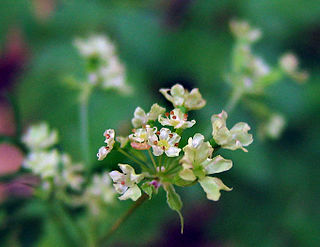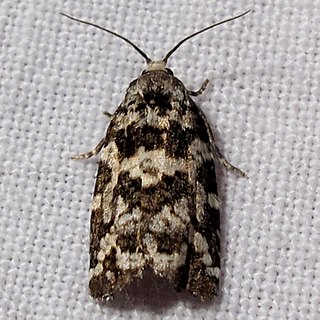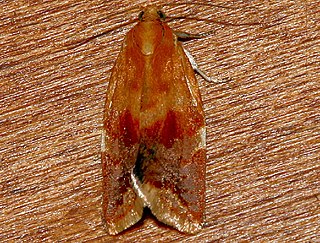The Prodoxidae are a family of moths, generally small in size and nondescript in appearance. They include species of moderate pest status, such as the currant shoot borer, and others of considerable ecological and evolutionary interest, such as various species of "yucca moths".

Spondylidinae are a small subfamily of Cerambycidae including slightly over 100 species, primarily in the coniferous forests of the Boreal hemisphere. A few species occur in coniferous forests in tropical and subtropical areas, while very few genera are present in Austral Africa and Madagascar. Some sources spell the name as Spondylinae.

Osmorhiza brachypoda is a species of flowering plant in the family Apiaceae known by the common name California sweetcicely.
Greya is a genus of moths of the family Prodoxidae.
Greya variata is a moth of the family Prodoxidae. It is found in herb-rich meadows and along forest edges in the central Rocky Mountains at the border between the United States and Canada.
Greya variabilis is a moth of the family Prodoxidae. It is found on the Yugorski, Taymyr and Chukchi peninsulas of arctic Russia, the Pribilof Islands, Alaska and along the North American west coast. In the northern part of the range, the habitat consists of tundra. In the south, it occurs in moist coniferous forests.
Greya pectinifera is a moth of the family Prodoxidae. It is found in moist coniferous forests on the Olympic Peninsula and in the Mount Rainier region of the Cascades in Washington.
Greya politella is a moth of the family Prodoxidae. It is found from southern British Columbia to the Channel Islands of California and the southern Sierra Nevada, and from the Pacific coast to eastern Idaho and south-western Colorado.
Greya enchrysa is a moth of the family Prodoxidae. It is found in open, grassy pine forests in the drier interior regions of southern British Columbia, Alberta, Washington, Oregon, Idaho and western Montana.
Greya piperella is a moth of the family Prodoxidae. In North America it is found from southern British Columbia to central Oregon, west to western Montana. There is an isolated population in central California and the species is possibly also present in New Mexico and Utah. The habitat consists of open, grassy pine forests or rockfaces in open country.
Greya punctiferella is a moth of the family Prodoxidae. It is found in the Pacific coastal ranges, the western slopes of the Cascades and in parts of the Sierra Nevada from south-eastern Alaska in the north to the Mendocino region of northern California in the south. The habitat consists of moist, coniferous or mixed conifer-Alnus forests.
Greya obscura is a moth of the family Prodoxidae. It is found from south-western Oregon to the San Garbriel Mountains and the southern Sierra Nevada of California. The habitat consists of grassy portions of open oak woodland.
Greya powelli is a moth of the family Prodoxidae. It is found in the coastal range between the San Francisco Bay area and the San Gabriel Mountains, and in the south-central Sierra Nevada of California. The habitat consists of slightly moist grassy areas in open oak woodland.
Greya suffusca is a moth of the family Prodoxidae. It is found in the Sierra Nevada near Sequoia National Park in California. The habitat consists of oak and mixed oak-conifer forest.
Greya solenobiella is a moth of the family Prodoxidae. In the United States it is found from south-western Oregon south to California, where it is found along the coast and in the Sierra Nevada. The habitat consists of grassy areas in dry to moderately moist oak or mixed deciduous forests.
Greya sparsipunctella is a moth of the family Prodoxidae. It is found along the northern California coast of the United States. The habitat consists of low, forb-rich ocean cliff vegetation and moist coniferous forest.
Greya reticulata is a moth of the family Prodoxidae. It is found from the coastal range of California in the United States.
Greya subalba is a moth of the family Prodoxidae. In North America it is found in southern British Columbia, Alberta, Washington, Oregon, northern Idaho, western Montana and south to south-western Oregon. The habitat consists of dry, forb-rich steppe.

Archips packardianus, the spring spruce needle moth or spruce needleworm, is a species of moth of the family Tortricidae. Spruce needle worms are commonly found in small numbers on spruce and trees of other coniferous genera throughout most of Canada and the northeastern US. Archips packardiana overwinters as a tiny larva in a mined needle. Needle mining is resumed in the spring, the larvae later moving to feed on new foliage, where they spin considerable webbing. Full-grown larvae have a pale green head, sometimes patterned with brown, and a pale body and pale thoracic legs, and are about 20 mm long. The larva pupates, usually in the webbed needles, and the adult emerges in summer to early fall. The closely related Archips strianus is much less common, but probably has a habitat similar to that of A. packardiana. The larvae have dark thoracic legs and small dark areas around the base of the thoracic hairs. The habitat consists of coniferous and mixed woods.

Clepsis persicana, the white triangle tortrix or the green needleworm, is a species of moth of the family Tortricidae. It is found in North America, where it has been recorded from Alaska and British Columbia to Newfoundland and south to Virginia and west to California. The habitat consists of coniferous and mixed coniferous forests.



